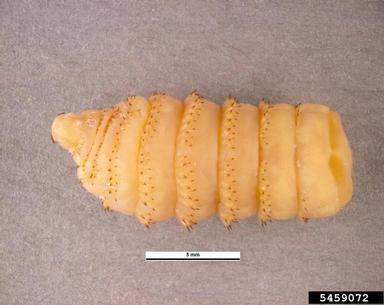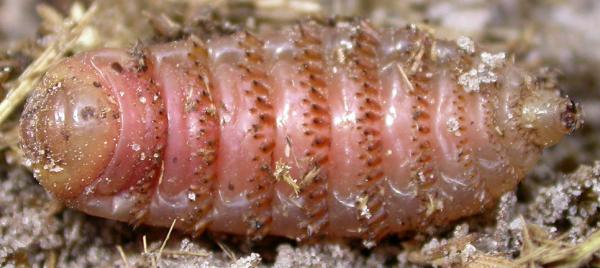Life Cycle
Gasterophilis intestinalis, or the horse
bot fly, ihas an annual life cycle. Studies have shown egg counts
peak in the fall (Piol et al., 2009; Sánchez-Andrade, 2010).
This is most likely due to the easier mobility that comes with
higher precipitation during the fall season and other limiting
resources (Güiris et al., 2010). Most commonly, the eggs are
found attached to hairs of the more anterior limbs of their host
(Pilo et al., 2009). The eggs are triggered to molt to the first
stage larvae through contact with the host’s saliva
(Sánchez-Andrade, 2010). Therefore, it is advantageous for them
to be in an area that their host can reach with its mouth, which
the host ofte n uses as a means to relieve the irritation of the
eggs’ existence.
n uses as a means to relieve the irritation of the
eggs’ existence.
After about a month in the host’s mouth, the eggs will molt to the next stage larvae. This second instar larvae then begin to transcend down the digestive tract toward the stomach. In the stomach another molt occurs, producing the third stage larvae. These larvae stick to the mucosa of the walls of the digestive tract for eight to ten months where they can obtain nutrients from their host (Roelfstra, 2010; Sánchez-Andrade, 2010). Third stage larvae then exit, along with all other waste, through the anus of the host. Studies have shown this occurs most commonly in the spring (Sánchez-Andrade, 2010). Some studies figure this out by actually counting the number of larvae in feces (Güiris et al., 2010), while other studies analyze the fluctuations in the host’s immune response to the parasite (Sánchez-Andrade, 2010). Pest and Diseases Image Library, Bugwood.org
Next, the third stage
larvae go through a process of pupation over the summer, in
which the amount of ti me it takes fluctuates along with the
temperature. Usually, it takes a little over a month for adult
flies to emerge (Sánchez-Andrade, 2010). They must find a male
or female counterpart rather quickly because adult flies only
live for a little over a week. This typically is not difficult.
Once a new setting is introduced to a fly, high egg deposits,
successful life cycles and short generation times allow for a
boom in numbers. Upon meeting, fertilization only takes a matter
of minutes. Then, after a couple hours, the female is ready to
deposit her eggs onto a host (Featured Creature, 1996). Optimal
conditions include no rainfall and a temperature above 15 °C for
flight ability (Sánchez-Andrade, 2010). Also, it is more
advantageous for the continuation
Photo Taken by Benoit Martha of her heredity to deposit a
few eggs on different hosts (Featured Creature, 1996). This
starts the cycle over again.
me it takes fluctuates along with the
temperature. Usually, it takes a little over a month for adult
flies to emerge (Sánchez-Andrade, 2010). They must find a male
or female counterpart rather quickly because adult flies only
live for a little over a week. This typically is not difficult.
Once a new setting is introduced to a fly, high egg deposits,
successful life cycles and short generation times allow for a
boom in numbers. Upon meeting, fertilization only takes a matter
of minutes. Then, after a couple hours, the female is ready to
deposit her eggs onto a host (Featured Creature, 1996). Optimal
conditions include no rainfall and a temperature above 15 °C for
flight ability (Sánchez-Andrade, 2010). Also, it is more
advantageous for the continuation
Photo Taken by Benoit Martha of her heredity to deposit a
few eggs on different hosts (Featured Creature, 1996). This
starts the cycle over again.
Want to learn more about the horse bot fly's interaction with its host and other organisms?!
Want to go home?